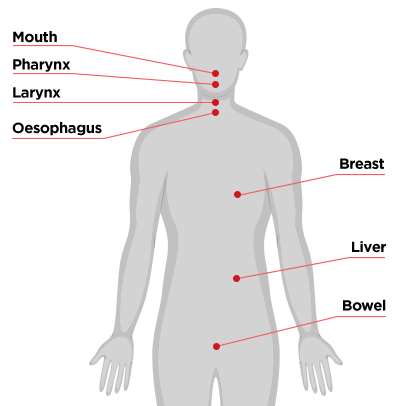There is a strong link between alcohol and cancer.
Alcohol is responsible for more than 5,000 new cancer cases in Australia each year.
Alcohol is currently classified as a Group 1 carcinogen. That’s the same classification held by tobacco smoke and asbestos.
Research shows there is no safe level of alcohol consumption, and the risk of alcohol-related cancers increases with the amount you drink.
But reducing your alcohol use can reduce your risk.
Alcohol is linked to cancer in at least seven sites in the body:
- Mouth
- Pharynx (throat)
- Larynx (voice box)
- Oesophagus
- Liver
- Bowel
- Breast

Alcohol damages the cells of the body and increases the risk of alcohol-caused cancer
Five ways alcohol increases your risk of cancer
- Alcohol influences hormone levels – Alcohol can impair the body’s hormone system. This can increase the risk of breast cancer.
- Alcohol damages your body – When alcohol breaks down it forms acetaldehyde, a known carcinogen that damages your cells. It also causes direct tissue damage, affecting areas like your mouth, pharynx, oesophagus, colon and liver
- Alcohol reduces folate absorption – Long-term risky alcohol use reduces the amount of folate your body can absorb. This impacts cell structures and increases the likelihood of alcohol-related cancers.
- Alcohol mixes with other cancer-causing substances – Alcohol can mix with other known carcinogens in your body like tobacco, forming compounds that damage cells.
- Alcohol contributes to weight gain – Alcohol is high in calories. The same goes for drinks that are usually mixed with it. Being above healthy weight increases your risk of many cancers.
Talk to your doctor today about reducing your risk.
Download an information sheet about alcohol and cancer.
The less you drink, the healthier you are
If you drink alcohol, Australia’s new Alcohol Guidelines recommend you have no more than four standard drinks in a day and no more than 10 standard drinks a week.
You can learn more about the new Australian Alcohol Guidelines here.
What is a standard drink?
One standard drink contains 10 grams of alcohol, which looks different depending on the type of drink and the glass or container it is served in. One standard drink equates to a can of mid-strength beer, a 100 ml glass of red wine, or a 30 ml shot of spirits.
To learn more about a standard drink, check out the Australian Department of Health guide on standard drinks.
About this project
This project was developed by the Foundation for Alcohol Research and Education (FARE), supported by the ACT Government under the ACT Health Promotion Grants Program.
It has been adapted from the WA Mental Health Commission’s Spread campaign and reflects the National Health and Medical Research Council’s new Australian Guidelines to Reduce Health Risks from Drinking Alcohol.
